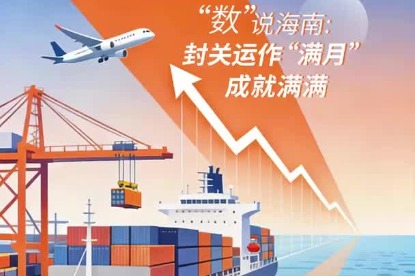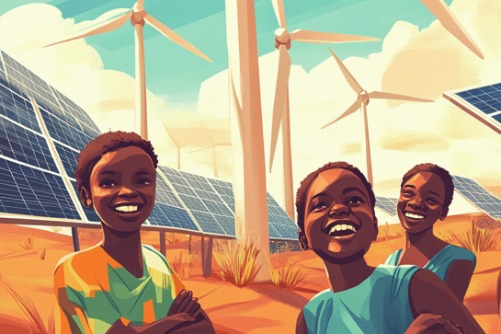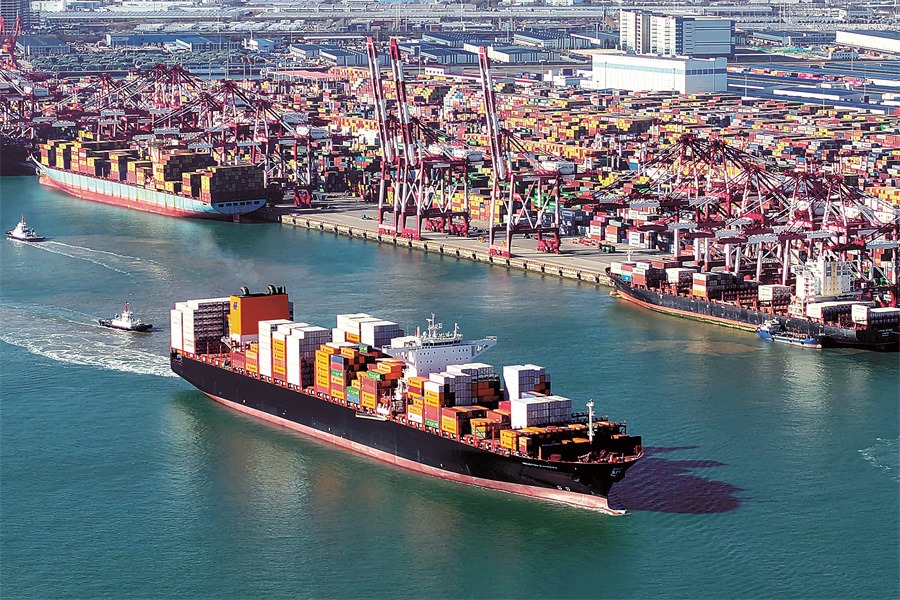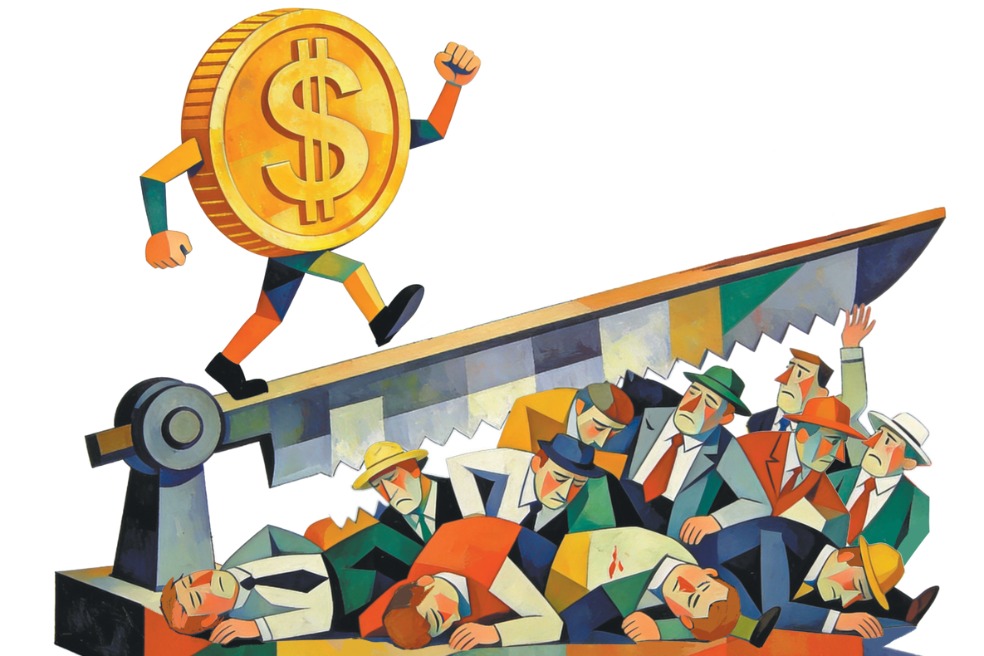A time for Shambhala: Coronavirus, capital collapse, and re-coding the planet paradigm


The author on set in the Himalayas filming "Searching for the Lotus Born Master" [Photo provided t chinadaily.com.cn]
Shangri-la as Immunization Against Global Debt Finance
Let me tell you a story about searching for a place called "Shangri-la." You may not believe in it. Especially at a time like this when the world is in chaos. Maybe you don’t think it exists. But if determined, you can certainly try and look for it. Maybe you will be surprised at what you find. It is at times like this that people search for Shangri-la.
In 2002, I decided to end my career working as a lawyer for Fortune 500 companies for ethical reasons. Their disregard for the environment and damage to communities and cultures were my main concerns. As a lawyer I was an insider, and could see how management manipulated stock prices for their own benefit, not the shareholders they were supposed to represent. As a lawyer I could not facilitate these interests anymore. So I decided to search for Shangri-la.
"Shangri-la" was first coined by James Hilton in his novel "Lost Horizons," published in 1933. The novel became enormously popular and even one of Hollywood’s first blockbusters in 1937. Why was it so popular? It was the Great Depression when people lost all hope in capital markets, materialism and the ability of Western governments to cope with crisis. So they turned to Asian mysticism and visions of a harmonious society with a common shared destiny as presented in the concept of Shangri-la.
According to UShistory.org: "So what happened during the Great Depression. The richest 1 percent of Americans owned over a third of all American assets. The wealthy tended to save money that might have been put back into the economy if it were spread among the middle and lower classes. Middle class Americans had already stretched their debt capacities by purchasing automobiles and household appliances on installment plans."
The "roaring '90s" was the "roaring '20s" all over again. It was a time that would become known as the dot.com phase in the era of so-called globalization. Bill Clinton was president of the United States of America. Under his administration an important piece of legislation called the Glass-Steagall Act was repealed. This legislation had been in place since the Great Depression and was key in protecting common people. It required certain capital ratios in banks, and prevented banks from speculating in the stock market with depositor money.
With Glass-Steagall gone, banks and investment banks joined hands and invested in anything they could flip in the market. Stock prices soared and old-fashioned economics went out the door. Profit and loss did not matter. A concept of "shareholder’s value" kicked in meaning that the management could just burn the money and shareholders would hope they were making the right decisions on potential market share that could be realized, or maybe not. Our spirit of competition was now taken over by monopoly companies. Media created CEO celebrities. Having been lawyer to a number of them, I realized their sole interest was to push stock prices up, bail out before retirement, and invest in fancy luxury cars and gold plated toilet seats for their big estate homes.
Funny how things repeat, and repeat, and yes, keep repeating. Following the Great Depression and World War II, Milton Friedman’s unfettered market capitalism became the language of both Wall Street and Capital Hill. Fast forward, Milton Friedman’s "the market knows best" and "greed is good" unrestrained capital stuff culminated in the sub-prime crisis and collapse of capital markets in 2008. The solution? Print more money against debt purchased backed by the Federal Reserve. That meant that rather than correcting the global financial and corporate system, more debt money flooded into it.
The solution? It should have been a restructuring of our entire financial system and the values and assumptions that underlie it. But it wasn’t. The solution was to print more money against debt purchased back by the Federal Reserve. More debt money flooded into the market and into the technically bankrupt banks and investment banks that then invested in more speculative stocks. Sound familiar?
Guess what the banks did? Pour money into more so-called tech stocks and the market surged all over again. This policy of George Bush Jr. ran on a beeline right through the years of Barak Obama’s presidential administration.
While Donald Trump criticized the QE and growing debt conundrum in his election campaign, when assuming the throne of president, he used the exact same methods just changing the name from QE to repo. He then multiplied the debt to astronomical levels. One could say repo is QE on steroids. Whatever debt Obama issued in a month, Trump issued it each day. So everything repeated just as before – only this time bigger and better --waiting for the next trigger event that would bring the whole house of cards down. Fast forward to 2019. Any event – a terrorist attack, a natural disaster – could have brought the house of cards down. It was coronavirus.
Global Shock – We Need a Pyramid with Foundations, Not a Bubble
America’s national debt counts 105 percent of GDP. America’s corporate debt counts 75 percent of GDP. American household debt is $14.15 trillion, or 65 percent of GDP. This is the highest in American history, in fact the history of the world. Remember what happened to Mars?
America’s economic growth comes from two drivers: industrial labor and credit expansion. Today the economic growth is mainly dependent upon credit growth and not actual productivity. Credit growth cannot salvage the real economy if there is none. Excess credit will not invest in productivity but rather will speculate on stocks and debt instruments. Since 2014 the American stock market has gone up while commodities have gone down which is a phenomena that tells us that investment in real production has gone south while investment in fuzz has gone up. Look at Facebook, Twitter, and other social media platforms.
America’s debt has reached the peak. When people cannot pay their interest rates, much less principal, then the debt bomb crisis is coming. It is about to be nuclear. America’s GDP is only about 2.3 percent. Its unemployment rate may hit 9 percent in the coming months.
Eight people in the world have enough wealth to feed 370 million people. In today’s world one percent of the rich people’s assets combined is more than 99 percent of people’s global assets aggregated. Those eight people could end poverty, eliminate all student debt, transfer major energy grids from fossil fuels to green energy, socialize medicine for all. But will they do that? Unfortunately, they won’t. They want more profits from share price manipulation on capital markets.
As the American capital markets crashed, on March 18 a series of unthinkable moves took place. The Federal Reserve shot off all of its ammunition in one go throwing a trillion dollars of debt money in the market. It uplifted the market momentarily and then it sunk again. They repeated. Same result.
The next day, they ran out of tools. So what did they do? Shut the market down. Open and shut, whenever it drops too much. Wow! The US media and politicians criticized China when they did this in a market crash but when they do it nobody says anything! What else did the Fed do when it ran out of its classic interest rate drop and debt buy-back tools? They claim to have lots of free-wheeling market tools to play with. So what did they do? So they began to buy corporate bonds. What does that mean? That’s not a market tool. Technically it’s a form of nationalization. Europe follows suit.
As shares crashed and talking heads tried to keep and upbeat banter further some telling responses revealed. Facebook announced immediately that it would give $1,000 bonuses to all employees. Wynn casinos announced that it would maintain existing payrolls plus tips to all employees to stay home during coronavirus. In short, the extreme rich are scared because they know what is coming. During the French Revolution, Queen Marie Antoinette told the starving French mob to "eat cake." They cut her head off instead. In short, that’s what is coming. Mobs have already ransacked supermarkets and stores in big cities. Police departments of several major cities have announced that they will not pursue minor crimes like store robbery and car hijacking. In short, they have to let some of the steam out of the vent otherwise the whole thing will explode.
Searching for a New Economic Paradigm – Shambhala
Now back to the story of Shangri-la.
Many colleagues and friends wondered why I decided to leave the fast investment lawyer life, and re-incarnate in a single lifetime as a Himalayan explorer and film director. Actually it was a very easy decision. I will explain why.
From 2002 onwards I led a series of documentary film expeditions across the Himalayan region, searching for the lost, mythical kingdom of Shangri-la. Some thought the idea terribly romantic, others just outright crazy.
The "Searching for Shangri-la" documentary film series was an outcome of those expedition years. There were three films: "Searching for Shangri-la," "Conversations with Sacred Mountains," and "Shambhala Sutra." In 2016, the Searching for Shangri-la expeditions received the National Geographic Air and Water Conservation Award for raising climate change awareness.
During these years our expedition film team crossed some of the most remote regions of the Qinghai-Tibetan plateau asking one single question: where is Shangri-la? Actually, we never found it.
These documentary film expeditions brought into sharp focus startling concerns. Glacial melt from climate disruption would result in water shortages and natural catastrophe. When filming in the ancient lost civilization of Guge rising from the deserts of western China, I realized that civilizations do not rise and fall on stock prices. Rather they rise and fall on people’s access to water.
During those years I saw the Brahmaputra River, once powerful and overwhelming, become a mere creek with sand dunes on both sides in some areas of the plateau. It became clear that we can give our children money, education, a car and all that. But none of us can guarantee our children water to drink in the future.
Throughout these expeditions I was deeply inspired by people along the journey, each in their individual way trying to preserve their own local culture and environment. The intention of each was in the right place. The question in my mind was how to scale this?
It was clear, social stability comes from community empowerment. That requires healthy, pragmatics economics and respect for local culture and identity. The globalization model of multinational corporate monopoly – chain store domination of process and commodities -- would certainly flatten communities as advocated by those western economists calling for a "flat" world. But that would not guarantee a healthy or safe world.
The world is not flat. It is round complex, and diverse. We have to respect that diversity and maintain its richness through local economics that brings communities back together. That requires a combination of pragmatic economics and local cultural respect. There may not be any one single approach either. Different solutions work for different peoples, communities and nations. So the cookie cutter one-model-fits-all promoted by western economists in the era of the 1990s-2000s does not necessarily work across countries and cultures.
Inspired by the local efforts of people across the Himalayan plateau to protect diverse cultures and climate of so many ethnic groups, I ended up spending the next decade establishing one of Asia’s earliest social enterprises, opening medical clinics, funding eye operations to cure blindness which is a common problem at high altitudes, and eventually serving as senior advisor to China’s Ministry of Environmental Protection in coordinating the drafting the Ecological Civilization policy that would set China on a trajectory toward 80 percent green energy by 2050.
It was clear then that the economic systems that we have taken for granted will have to change for our planet to survive amidst growing populations, energy, food consumption and healthcare needs. I put my lawyer hat back on, this time as an environmental activist, working with UN organizations on climate issues. The Himalayan Consensus process and Silk-Spice Road Dialogues in partnership with UNDP emerged from these years and experiences.
The Himalayan Consensus called for the following key principles: 1) protect local culture and identity; 2) through sustainable business models that are practical; 3) prioritize protection of the environment with green energy and water conservancy technologies being drivers for the future; 4) conflict is caused when people are disempowered or their identity is marginalized. The Silk-Spice Road Dialogues seeks to: 1) prevent conflict through solutions for economic empowerment of communities and protection of their environment using green finance for environmental technologies; 2) preventing of crisis through enhancing regional cooperation rather than differences on such issues as the one facing us all – pandemics.
The Legend of Shambhala - It is Not a Legend, It is Happening.
Back to the Searching for Shangri-la film expeditions and several take-away points:
"Shangri-la" is a misspelling of the word "Shambhala". While first appearing in ancient Hindu literature, it had evolved over thousands of years to become a core concept of Vajrayana Buddhism. The concept of Shambhala became absorbed into many Himalayan cultures and ethnic groups. It is well understood from Pakistan, India, Nepal, Bhutan and of course across the Tibetan regions of western China. The narrative goes like this:
The first Kalki King of Shambhala named Suchandra learned the Kalachakara practice (in quantum physics the theory of a unified quantum field) that pierces time and space (Einstein figured this out about 2,400 years later) and brought it back to Shambhala, which on one hand is a parallel universe or alternate non-bilateral dimension. Or if you insist on GPS coordinates, it is somewhere north of the Himalayas.
In Shambhala, everyone practices Kalachakra (the wheel of time that allows one to move the mind beyond compression coordinates of time and space) and therefor takes a quantum view of everything. That means we are part of a universal matrix that is interconnected and that everyone’s action is deeply integrated with an outcome that will affect everyone else.
So guess what everyone in Shambhala does? They work together! No fighting allowed. They care for their environment and in turn nature protects them. There are no poor and no extreme rich. Everyone gives and takes care of everyone else. There is an understanding that everyone and everything is interconnected as part of a universal matrix with a shared common destiny. Everyone works together to make things better.
According to the Shambhala prophesies that appear in various literature sources in Asia, some 2,500 years after the Nirvana of Buddha Shakyamuni, the world is in a state of chaos called the Kali Yuga or "Age of Destruction." We are more or less in this time zone right now.
The narrative goes that during the Kali Yuga an empire rises in the west and tries to dominate the world making all other nations conform with its guiding principles of: unfettered greed, shortsightedness, and the fostering of anger. Outcomes are destruction of the environment resulting in natural disasters and unforeseen epidemics that cannot be cured. The rich become richer and the poor poorer. The promotion of anger through the empire’s media, social media and lack of gun control leads to unnecessary violence and endless wars.
Imagine the Future - Shambhala
Now this is when our second set of Himalayan expeditions comes in. In 2017 our studio began another documentary film series: Searching for the Lotus-Born Master and our sequel documentary film "Return of the Lotus-Born Master." The Lotus-Born Master who was arguably the founder of Tantric Buddhism was also possibly the father of quantum physics.
He prophesied his own return in a Camelot role leading the knights of Shambhala during the Age of Destruction to rid our planet of the demons of greed, shortsightedness and anger. One can easily imagine that we are in this time now. Certainly the coronavirus prophesies of unforeseen and incurable pestilence sparking this epic battle between a world of greed, shortsightedness and anger juxtaposed against one of compassion and harmony fostered through a common shared destiny, were all predicted in the prophesies.
So one can imagine when the Lotus-Born Master returns and takes his seat as the future king of Shambhala, that he may very well abolish fossil fuels, promote green finance, tightly regulate the trading of derivatives, raise the capital requirements of banks, and eliminate student debt. He may insist that big data should be used for smart infrastructure management, green energy grids and real time health care response, rather than for spying on people’s personal interests to hijack their minds as is the case today with certain Big Tech monopolies. He will certainly insist that technology needs to now be applied to green energy and health care solutions not violent video games and anger-fostering social media platforms that only divide people against them selves.
The coronavirus crisis shoves into our face a choice. Do we work together to solve challenges like pandemics, environmental deterioration and climate distortion, gaps between rich and poor, heath and well being as a shared common destiny that each and everyone of us is part of and has our part to play? That will require re-assessing our global values, re-configuring our global financial system, re-applying technologies in a way that benefits rather than hurts and divides people. In short re-coding the planet paradigm.
This planet is just a tiny space ship or oxygen ball floating in vast darkness out there. If we do not work together and re-adjust our economic systems, technology focus and overarching mindset, then that little space ship called earth is going to crash. We are all interlinked into a common matrix that has a shared destiny. That applies to mankind, animals, all life on this planet for that matter. Yes, we are all in this thing together so now it is time to put down differences and work together.
So, what do you think? Is it is time that we all start searching for Shambhala. Or better yet, let’s create it.
Laurence Brahm is an award winning documentary film director and Himalayan explorer, and he is also a senior international fellow at the Center for China and Globalization.
The opinions expressed here are those of the writer and do not represent the views of China Daily and China Daily website.


































